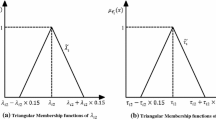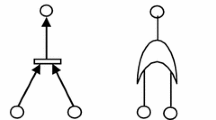Abstract
Uncertainties play a dominant role in the performance analysis of the system. For managing it, fuzzy set theory and its corresponding triangular fuzzy numbers have been utilized by most of the researchers for quantifying the data. However, in this manuscript, this hypothesis has been calmed by defining the different types of numbers, namely gamma, normal, Cauchy and triangular for uncertainties. Based on it, behavior, performance and sensitivity analysis of the system have been investigated at different levels of confidence and the preferences as provided by the decision makers towards the data. Based on it, various expressions of the system such as failure rate, repair time, reliability, availability etc., are obtained corresponding to these different types of the numbers. From the computed results, it is concluded that these indices are reduced range of prediction as compared to the existing approaches. A numerical example has been taken for demonstrating the approach.







Similar content being viewed by others
References
Chen SM (1994) Fuzzy system reliability analysis using fuzzy number arithmetic operations. Fuzzy Sets Syst 64(1):31–38
Chen SM (1996) New method for fuzzy system reliability analysis. Cybern Syst Int J 27:385–401
Cheng CH, Mon DL (1993) Fuzzy system reliability analysis by interval of confidence. Fuzzy Sets Syst 56(1):29–35
Ebeling C (2001) An introduction to reliability and maintainability engineering. Tata McGraw-Hill Company Ltd., New York
Garg H (2013) Reliability analysis of repairable systems using Petri nets and Vague Lambda–Tau methodology. ISA Trans 52(1):6–18
Garg H (2014) Reliability, availability and maintainability analysis of industrial systems using PSO and fuzzy methodology. MAPAN J Metrol Soc India 29(2):115–129
Garg H (2015a) An approach for analyzing the reliability of industrial system using fuzzy Kolmogorov’s differential equations. Arab J Sci Eng 40(3):975–987
Garg H (2015b) A hybrid GA-GSA algorithm for optimizing the performance of an industrial system by utilizing uncertain data. In: Handbook of research on artificial intelligence techniques and algorithms. IGI Global, Hershey. https://doi.org/10.4018/978-1-4666-7258-1.ch020
Garg H (2016) A novel approach for analyzing the reliability of series–parallel system using credibility theory and different types of intuitionistic fuzzy numbers. J Braz Soc Mech Sci Eng 38(3):1021–1035
Garg H (2017) Performance analysis of an industrial system using soft computing based hybridized technique. J Braz Soc Mech Sci Eng 39(4):1441–1451
Garg H, Sharma SP (2012a) Behavior analysis of synthesis unit in fertilizer plant. Int J Qual Reliab Manag 29(2):217–232
Garg H, Sharma SP (2012b) Stochastic behavior analysis of industrial systems utilizing uncertain data. ISA Trans 51(6):752–762
Garg H, Sharma SP (2013) Multi-objective reliability-redundancy allocation problem using particle swarm optimization. Comput Ind Eng 64(1):247–255
Garg H, Rani M, Sharma SP (2014a) An approach for analyzing the reliability of industrial systems using soft computing based technique. Exp Syst Appl 41(2):489–501
Garg H, Rani M, Sharma SP, Vishwakarma Y (2014b) Bi-objective optimization of the reliability-redundancy allocation problem for series–parallel system. J Manuf Syst 33(3):335–347
Garg H, Rani M, Sharma SP, Vishwakarma Y (2014c) Intuitionistic fuzzy optimization technique for solving multi-objective reliability optimization problems in interval environment. Exp Syst Appl 41:3157–3167
Gupta S, Bhattacharya J (2007) Reliability analysis of conveyor system using hybrid data. Qual Reliab Eng Int 23(7):867–882
Huang HZ, Tong X, Zuo MJ (2004) POSBIST fault tree analysis of coherent systems. Reliab Eng Syst Saf 84(2):141–148
Huang HZ, Zuo MJ, Sun ZQ (2006) Bayesian reliability analysis for fuzzy lifetime data. Fuzzy Sets Syst 157(12):1674–1686
Jiang Q, Chen CH (2003) A numerical algorithm of fuzzy reliability. Reliab Eng Syst Saf 80:299–307
Klir GJ, Yuan B (2005) Fuzzy sets and fuzzy logic: theory and applications. Prentice Hall of India Private Limited, New Delhi
Knezevic J, Odoom ER (2001) Reliability modeling of repairable systems using Petri nets and Fuzzy Lambda–Tau methodology. Reliab Eng Syst Saf 73(1):1–17
Kumar P, Aggarwal KK (1993) Petri net modeling and reliability evaluation of distributed processing systems. Reliab Eng Syst Saf 41(2):167–176
Lei XR, Ren Z, Huang WY, Chen BY (2005) Fuzzy reliability analysis of distribution systems accounting for parameters uncertainty. In: Proceedings of 2005 international conference on machine learning and cybernetics, vol 7, pp 4017–4022. https://doi.org/10.1109/ICMLC.2005.1527640
Mon DL, Cheng CH (1994) Fuzzy system reliability analysis for components with different membership functions. Fuzzy Sets Syst 64(2):145–157
Rani D, Gulati TR, Garg H (2016) Multi-objective non-linear programming problem in intuitionistic fuzzy environment: optimistic and pessimistic view point. Exp Syst Appl 64:228–238
Ross TJ (2004) Fuzzy logic with engineering applications, 2nd edn. Wiley, New York
Sharma SP, Garg H (2011) Behavioral analysis of a urea decomposition system in a fertilizer plant. Int J Ind Syst Eng 8(3):271–297
Singer D (1990) A fuzzy set approach to fault tree and reliability analysis. Fuzzy Sets Syst 34(2):145–155
Utkin LV, Gurov SV (1998) Steady-state reliability of repairable systems by combined probability and possibility assumptions. Fuzzy Sets Syst 97(2):193–202
Valipour M (2016) Variations of land use and irrigation for next decades under different scenarios. Irriga Braz J Irrig Drain 1(1):262–288
Valipour M, Banihabib ME, Behbahani SMR (2013) Comparison of the ARMA, ARIMA, and the autoregressive artificial neural network models in forecasting the monthly inflow of Dez dam reservoir. J Hydrol 476:433–441
Zadeh LA (1965) Fuzzy sets. Inf Control 8:338–353
Acknowledgements
This work has been supported by the Thapar Institute of Engineering & Technology (Deemed University) under SEED Money Grant wide Letter No. TU/DORSP/57/1910.
Author information
Authors and Affiliations
Corresponding author
Ethics declarations
Conflict of interest
The authors declare that they have no conflict of interest.
Rights and permissions
About this article
Cite this article
Garg, H. Analysis of an industrial system under uncertain environment by using different types of fuzzy numbers. Int J Syst Assur Eng Manag 9, 525–538 (2018). https://doi.org/10.1007/s13198-018-0699-8
Received:
Revised:
Published:
Issue Date:
DOI: https://doi.org/10.1007/s13198-018-0699-8




